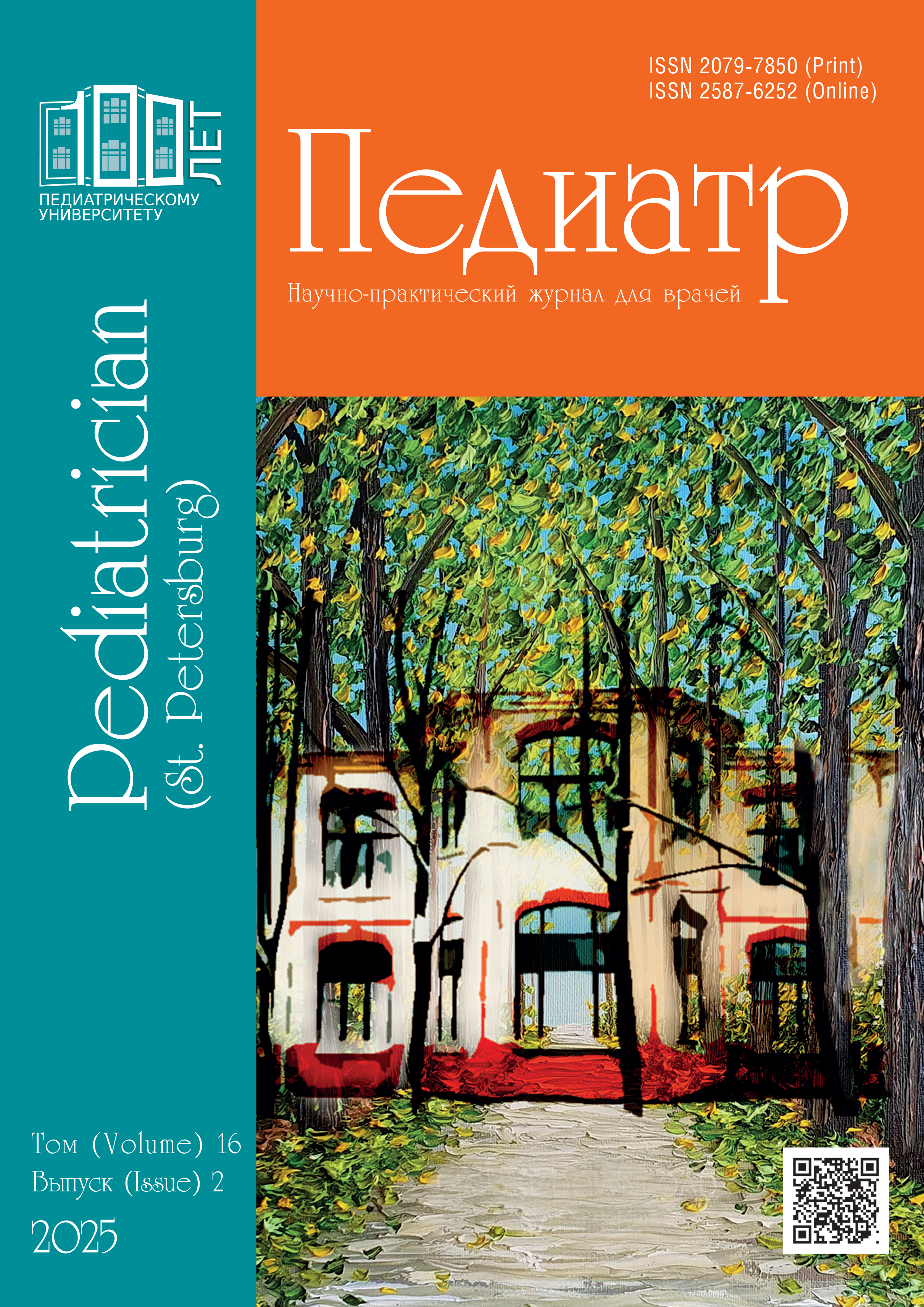A clinical case of drug treatment of pituitary gigantism
Abstract
Growth hormone-producing pituitary adenoma leads to pituitary gigantism in children and acromegaly in adults. There are currently no domestic federal clinical guidelines for pituitary gigantism, possibly due to the rarity of this pathology. Neurosurgery is recognized as the main treatment method for somatotropinoma, but the effectiveness and safety of such treatment are far from ideal. Somatostatin analogs are the most common pharmacological treatment for acromegaly; they are used as the first line of therapy for small adenomas. Dopamine receptor agonists can also be used for growth hormone-producing pituitary adenomas, especially with concomitant hyperprolactinemia. The article presents a case of a patient with pituitary gigantism, diagnosed at the age of eleven, who received drug treatment for 5 years. The results of a comprehensive laboratory and instrumental examination in a teenager with previously diagnosed pituitary gigantism to assess the effectiveness and safety of drug therapy are presented.
Pituitary gigantism is caused by endosellar pituitary macroadenoma. At the boy’s place of residence, at the age of 11.7 years, therapy with a dopamine recipes agonis (bromocriptine) was started. No mutations in the AIP and GNAS genes, leading, among other things, to the development of pituitary adenomas, were detected. Considering the insufficient effect of bromocriptine and the absence of direct indications for neurosurgical intervention at the age of 12.6 years, a decision was made to start therapy with a synthetic analogue of somatostatin. For five years, the patient received combined drug therapy with bromocriptine and prolonged-release octreotide. Clinical, laboratory and instrumental monitoring was carried out regularly (once a year). During the treatment, satisfactory results were observed for such laboratory parameters as IGF-1 (decreased from 677 to 248 ng/ml) and growth hormone (decreased 98,6 to 4.84 ng/ml). According to magnetic resonance imaging with contrast enhancement, the size of the pituitary adenoma also significantly decreased from 11.2×10.5×11.3 mm to 4.7×7.0×8.0 mm.
The use of drug therapy for pituitary gigantism in children can compensate for hormonal disorders, which makes it possible for the child to continue to grow and develop. Research is needed to select the most preferable treatment option.
References
Абдулхабирова Ф.М., Абросимов А.Ю., Александрова Г.Ф. и др. Эндокринология. М.: ГЭОТАР-Медиа, 2016. EDN: YPFEXX.
Астафьева Л.И., Кадашев Б.А., Сиднева Ю.Г. и др. Микроаденомы гипофиза: современное состояние методов диагностики и лечения. Вопросы нейрохирургии им. Н.Н. Бурденко. 2020;84(2):110–120. DOI: 10.17116/neiro202084021110.
Баркан А. Влияние предоперационной терапии аналогами соматостатина на исход хирургического лечения СТГ-продуцирующих макроаденом гипофиза: критический анализ. Эндокринная хирургия. 2018;12(1):7–18. DOI: 10.14341/serg9642.
Белая Ж.Е., Голоунина О.О., Рожинская Л.Я. и др. Эпидемиология, клинические проявления и эффективность различных методов лечения акромегалии по данным единого российского регистра опухолей гипоталамо-гипофизарной системы. Проблемы эндокринологии. 2020;66(1):93–103. DOI: 10.14341/probl10333.
Голоунина О.О., Дзеранова Л.К., Пигарова Е.А., Белая Ж.Е. Резистентность к медикаментозному лечению акромегалии и пути ее преодоления. Ожирение и метаболизм. 2021;18(2):150–162. DOI: 10.14341/omet12710.
Григорьев А.Ю., Азизян В.Н., Иващенко О.В. и др. Диагностика и новые возможности лечения аденом гипофиза. Проблемы эндокринологии. 2023;69(2):4–10. DOI: 10.14341/probl13199.
Дзеранова Л.К., Шутова А.С., Пигарова Е.А. и др. Опыт применения аналогов соматостатина пролонгированного действия у пациентов с ТТГ-секретирующими аденомами гипофиза. Ожирение и метаболизм. 2021;18(4):438–446. DOI: 10.14341/omet12768.
Иванов Д.О., Тыртова Л.В., Паршина Н.В. и др. Руководство по педиатрии. Т. 7. Эндокринология детского возраста. СПб.: СПбГПМУ; 2023. EDN: MDEUDN.
Крысанов И.С., Макарова Е.В., Ермакова В.Ю. Сравнительный фармакоэкономический анализ применения ланреотида пролонгированного действия для терапии акромегалии в условиях системы здравоохранения Российской Федерации. Фармация и фармакология. 2022;10(2):164–173. DOI: 10.19163/2307-9266-2022-10-2-164-173.
Лисс В.Л., Скородок Ю.Л., Плотникова Е.В. и др. Диагностика и лечение эндокринных заболеваний у детей и подростков. М.: МЕДпресс-информ; 2022.
Луценко А.С., Белая Ж.Е., Пржиялковская Е.Г. и др. Оценка краткосрочной и долгосрочной ремиссии акромегалии после эндоскопической трансназальной аденомэктомии. Проблемы эндокринологии. 2022;68(6):67–75. DOI: 10.14341/probl3192.
Морозов А.М., Сороковикова Т.В., Алутин А.Р. и др. Изменение когнитивных способностей после общей анестезии. Врач. 2023;34(9):25–29. DOI: 10.29296/25877305-2023-09-05.
Петренко Ю.В., Иванов Д.О., Мартягина М.А., Новикова В.П., Гурина О.П., Яковлев А.В., Исламова К.Ф. Инсулиноподобный фактор роста и его динамика у детей первого года жизни, рожденных от матерей с ожирением. Педиатр. 2019;10(1):13–20. DOI: 10.17816/PED10113-20.
Тыртова Л.В., Оленев А.С., Паршина Н.В., Скобелева К.В. Гипофизарный гигантизм. Возможности медикаментозного лечения. Педиатр. 2019;10(5):93–99. DOI: 10.17816/PED10593-99.
Шанин Ю.Н., Шанин В.Ю., Зиновьев Е.В. Антиоксидантная терапия в клинической практике: теоретическое обоснование и стратегия проведения. СПб: ЭЛБИ-СПб; 2003. EDN: ZDLQVN.
Burton T., Le Nestour E., Neary M. et al. Incidence and prevalence of acromegaly in a large US health plan database. Pituitary. 2016;19(3):262–267. DOI: 10.1007/s11102-015-0701-2.
Castellanos L.E., Misra M., Smith T.R. et al. The epidemiology and management patterns of pediatric pituitary tumors in the United States. Pituitary. 2021;24(3):412–419. DOI: 10.1007/s11102-020-01120-5.
Feola T., Pirchio R., Puliani G. et al. Sellar and parasellar lesions in the transition age: a retrospective Italian multi-centre study. J Endocrinol. 2023;46(1):181–188. DOI: 10.1007/s40618-022-01900-9.
Rojas G.W., Tovar C.H., Florez R.A. Pituitary gigantism: a case series from Hospital de San José (Bogotá, Colombia). Arch Endocrinol Metab. 2019;63(4):285–293. DOI: 10.20945/2359-3997000000150.
Lavrentaki A., Paluzzi A., Wass J.A. et al. Epidemiology of acromegaly: review of population studies. Pituitary. 2017;20(1):4–9. DOI: 10.1007/s11102-016-0754-x.
Losa M., Bollerslev J. Pros and cons in endocrine practice: pre-surgical treatment with somatostatin analogues in acromegaly. Endocrine. 2016;52(3):451–457. DOI: 10.1007/s12020-015-0853-x.
Molitch M.E. Diagnosis and treatment of pituitary adenomas. JAMA. 2017;317(5): 516–524. DOI: 10.1001/jama.2016.19699.
Vandeva S., Jaffrain-Rea M.L., Daly A.F. et al. The genetics of pituitary adenomas. Best Pract Res Clin Endocrinol Metab. 2010;24(3):461–476. DOI: 10.1016/j.beem.2010.03.001.
Wolf P., Salenave S., Durand E. et al. Treatment of acromegaly has substantial effects on body composition: a long-term follow-up study. European Journal of Endocrinology. 2022;186(2):173–181. DOI: 10.1530/EJE-21-0900.


